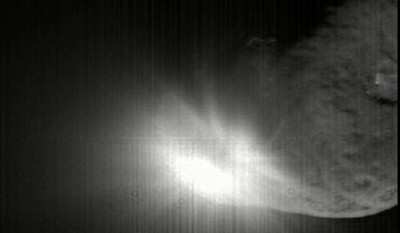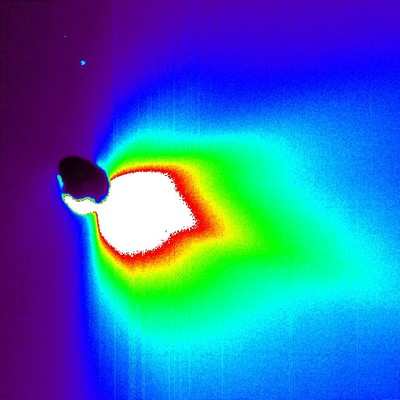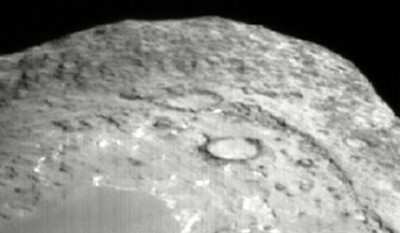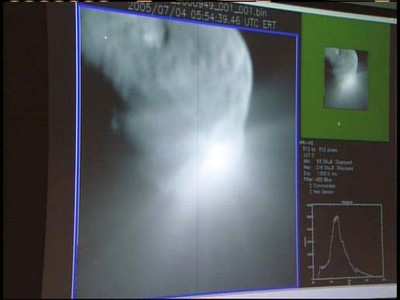Inside Story
Data from Deep Impact's instruments indicate an immense cloud of
fine powdery material was released when the probe slammed into the
nucleus of comet Tempel 1 at about 10 kilometers per second (6.3
miles per second or 23,000 miles per hour). The cloud indicated the
comet is covered in the powdery stuff. The Deep Impact science team
continues to wade through gigabytes of data collected during the
July 4 encounter with the comet measuring 5-kilometers-wide by
11-kilometers-long (about 3-miles-wide by 7-miles-long).

"The major surprise was the opacity of the plume the impactor
created and the light it gave off," said Deep Impact Principal
Investigator Dr. Michael A'Hearn of the University of Maryland,
College Park. "That suggests the dust excavated from the comet's
surface was extremely fine, more like talcum powder than beach
sand. And the surface is definitely not what most people think of
when they think of comets -- an ice cube."
How can a comet hurtling through our solar system be made of a
substance with less strength than snow or even talcum powder?
"You have to think of it in the context of its environment,"
said Dr. Pete Schultz, Deep Impact scientist from Brown University,
Providence, RI. "This city-sized object is floating around in a
vacuum. The only time it gets bothered is when the Sun cooks it a
little or someone slams an 820-pound wakeup call at it at 23,000
miles per hour."
The data review process is not overlooking a single frame of
approximately 4,500 images from the spacecraft's three imaging
cameras taken during the encounter.
"We are looking at everything from the last moments of the
impactor to the final look-back images taken hours later, and
everything in between," added A'Hearn. "Watching the last moments
of the impactor's life is remarkable. We can pick up such fine
surface detail that objects that are only four meters in diameter
can be made out. That is nearly a factor of 10 better than any
previous comet mission."

The final moments of the impactor's life were important, because
they set the stage for all subsequent scientific findings. Knowing
the location and angle the impactor slammed into the comet's
surface is the best place to start. Engineers have established the
impactor took two not unexpected coma particle hits prior to
impact. The impacts slewed the spacecraft's camera for a few
moments before the attitude control system could get it back on
track. The penetrator hit at an approximately 25 degree oblique
angle relative to the comet's surface. That's when the fireworks
began.
The fireball of vaporized impactor and comet material shot
skyward. It expanded rapidly above the impact site at approximately
5 kilometers per second (3.1 miles per second). The crater was just
beginning to form. Scientists are still analyzing the data to
determine the exact size of the crater. Scientists say the crater
was at the large end of original expectations, which was from 50 to
250 meters (165 to 820 feet) wide.

Expectations for Deep Impact's flyby spacecraft were exceeded
during its close brush with the comet. The craft is more than 3.5
million kilometers (2.2 million miles) from Tempel 1 and opening
the distance at approximately 37,000 kilometers per hour (23,000
miles per hour). The flyby spacecraft is undergoing a thorough
checkout, and all systems appear to be in excellent operating
condition.
The Deep Impact mission was implemented to provide a glimpse
beneath the surface of a comet, where material from the solar
system's formation remains relatively unchanged. Mission scientists
hoped the project would answer basic questions about the formation
of the solar system by providing an in-depth picture of the nature
and composition of comets.

The University of Maryland is responsible for overall Deep
Impact mission science, and project management is handled by JPL.
The spacecraft was built for NASA by Ball Aerospace &
Technologies Corporation, Boulder, Colo. JPL is a division of the
California Institute of Technology, Pasadena, CA.
 ANN's Daily Aero-Linx (04.15.24)
ANN's Daily Aero-Linx (04.15.24) Classic Aero-TV: 'No Other Options' -- The Israeli Air Force's Danny Shapira
Classic Aero-TV: 'No Other Options' -- The Israeli Air Force's Danny Shapira Aero-News: Quote of the Day (04.15.24)
Aero-News: Quote of the Day (04.15.24) Airborne 04.16.24: RV Update, Affordable Flying Expo, Diamond Lil
Airborne 04.16.24: RV Update, Affordable Flying Expo, Diamond Lil ANN's Daily Aero-Term (04.16.24): Chart Supplement US
ANN's Daily Aero-Term (04.16.24): Chart Supplement US






